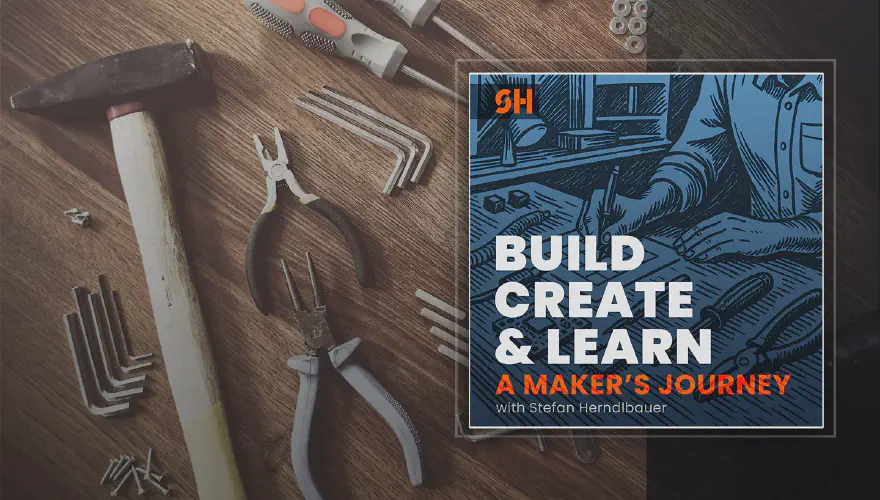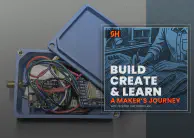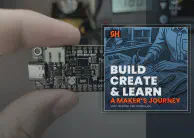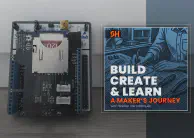Build, Create & Learn: A Maker's Journey Podcast - Episode 1

Join me as I design a custom telemetry device for my FPV drone from scratch — learning embedded programming, hardware selection, and LoRa communication along the way.
This blog has always been a place where I document how I tinker, design, and experiment — often hopping between disciplines and ideas. But a podcast felt like the perfect next step to share more of the why, the messy how, and the learning moments that never quite fit into a polished tutorial or Instagram clip.
Why a Podcast?
For as long as I can remember, I’ve been fascinated by people who build things — not just the final products, but the process. The prototype iterations, the ideas that don’t work, and the sparks of curiosity that lead to unexpected innovation.
When I listen to other makers or engineers talk about their projects, I can relate to their hunger for problem-solving. I wanted to give you a behind-the-scenes look at my workbench and show that it’s normal to sometimes feel stuck, pivot, or try wild ideas that might fail.
Build, Create & Learn — A Maker’s Journey is exactly that: a place where I explore what it means to be a modern maker, a curious tinkerer, and a multipotentialite in a world that often pushes you to just “pick one thing.” And what better way to kick it all off than with my latest rabbit hole — a custom FPV drone telemetry system.
The Project That Started It All
As I mention before in my blog I fly FPV drones in my spare time. There’s something magical about seeing the world from a few meters above the ground — twisting, looping, and racing around obstacles at speeds that make my heart race.

Because I fly a custom build and no off the shelf model, there was always one thing missing: DATA.
I’d finish a flight and think:
How fast was I actually going? How high did I climb on that last throttle punch?
My goggles and flight controller didn’t give me those insights — no fancy GPS or built-in telemetry. And for a curious mind like mine, that felt like leaving half the story untold.
So I wondered:
What if I could build a tiny device that logs all that information — speed, altitude, position — and beams it down to a ground station in real time?
That single question pulled me into a world I barely knew and great learning opportunities — embedded systems, LoRa radios, sensor fusion, STM32 programming — all at once.
And it felt like the perfect story to tell for my first episode: an honest look at how I tackle learning something completely new.
The Overwhelm of Hardware Choices
Starting out, the hardest part was simply choosing what to buy.
I remember staring at page after page of microcontrollers, GPS modules, and sensors — each with specs that made my head spin. I wanted something that could survive the vibrations and signal noise of a racing drone while being light enough to not ruin my flights.
In the end, I did what I always do when I don’t know everything: I made a few educated guesses, trusted some well-worn community tutorials, and just learn it by doing.
Right now, my setup looks like this:

-
Microcontroller — STM32 Nucleo-6 I chose the STM32 ARM Cortex M4F11RE on a Nucleo board.
- It has an onboard ST-Link debugger — perfect for someone new to STM32.
- I’ve done Arduino and ESP32 projects before, but this felt like the next level up.
- It’s affordable and has a solid community.
-
Environmental Sensor — BME280 This tiny chip measures humidity, air pressure, and temperature. It’s super popular for weather stations and drone telemetry because it’s accurate, cheap, and well-documented.
-
Motion Sensor — MPU-6050 A classic combo: 3-axis accelerometer + 3-axis gyroscope. This will help me measure tilt, orientation, and vibration during flights.
-
GPS Module — MTK3333 Breakout Board I wanted to capture speed and location, so a GPS was non-negotiable. This one supports up to 22 satellites on 66 channels and, honestly, it was the most budget-friendly module available in the store when I ordered the other parts.
What’s missing? You might notice: no LoRa module yet!
That’s planned for the next iteration. First, I want to see if I can collect and process sensor data reliably before tackling long-range wireless transmission.
Small Wins, Big Lessons
One thing I’ve learned as a generalist: your biggest barrier is often your own fear of not being an “expert.”
I still curious about whether these parts will play nicely together. Maybe I’ll fry a chip or spend hours debugging I2C addresses. But the only way to learn is to try — and share what I learn along the way.
I’ve already reorganized my electronics workbench, installed STM32CubeIDE, and read my first real datasheets without my eyes glazing over. That feels like progress.
Why Not Just Buy a Drone with GPS?
Fair question! Yes, I could just buy a drone with all this built in. But for me, building my own solution means:
- I learn deeply about embedded systems
- I develop skills I can apply to future projects
- I get the joy of figuring things out the hard way
Plus, who knows — maybe it’ll become a useful open-source design or a product other pilots can benefit from someday. I already have ideas where I can use this device as well in other projects in the future.
Where It’s Headed Next
Over the next few weeks, my goal is to:
- Get the microcontroller talking to the sensors
- Start logging basic data
- And plan how to add LoRa communication for long-range data transmission
Will it all work? Who knows! Maybe I’ll end up with a working device. Maybe I’ll pivot to something totally different. Either way, I’ll share every step — the triumphs and the “well, that didn’t work!” moments.
Listen In — And Join the Journey
If you enjoyed this story, I’d love for you to check out the full episode. I talk about why learning in public matters, the unexpected rabbit holes I’ve already fallen into, and what’s next for the project.
And if you’ve ever tackled something similar — or you’re knee-deep in a project that feels way above your pay grade — I’d love to hear about it. Drop me a message or connect with me on LinkedIn.
Let’s keep building, creating, and learning — together.


